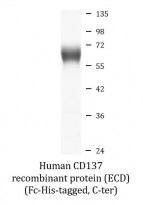ARG70291
Human CD137 recombinant protein (ECD) (Fc-His-tagged, C-ter)
Human CD137 recombinant protein (ECD) (Fc-His-tagged, C-ter) for Binding Activity,SDS-PAGE and Human
Overview
| Product Description | HEK293 expressed, Fc-His-tagged (C-ter) Human CD137 recombinant protein (ECD). |
|---|---|
| Tested Reactivity | Hu |
| Tested Application | Binding, SDS-PAGE |
| Target Name | CD137 (ECD) |
| Species | Human |
| A.A. Sequence | Leu24 - Gln186 of Human CD137 (NP_001552) with an Fc-6X His tag at the C-terminus. |
| Expression System | HEK293 |
| Alternate Names | ILA; CD137; T-cell antigen 4-1BB homolog; CDw137; T-cell antigen ILA; 4-1BB; CD antigen CD137; Tumor necrosis factor receptor superfamily member 9; 4-1BB ligand receptor |
Application Instructions
| Application Note | Binding activity test: Measured by its binding ability in a functional ELISA. Immobilized human TNFSF9 at 2 µg/ml (100 µl/well) can bind Human 4-1BB/CD137, the EC50 of Human 4-1BB/CD137 is 40-100 ng/ml. |
|---|
Properties
| Form | Powder |
|---|---|
| Purification Note | 0.22 µm filter sterilized. Endotoxin level is <0.1 EU/µg of the protein, as determined by the LAL test. |
| Purity | >97% (by SDS-PAGE) |
| Buffer | PBS (pH 7.4) |
| Reconstitution | Reconstitute to a concentration of 0.1 - 0.5 mg/ml in sterile distilled water. |
| Storage Instruction | For long term, lyophilized protein should be stored at -20°C or -80°C. After reconstitution, aliquot and store at -20°C for up to one month, at 2-8°C for up to one week. Storage in frost free freezers is not recommended. Avoid repeated freeze/thaw cycles. Suggest spin the vial prior to opening. |
| Note | For laboratory research only, not for drug, diagnostic or other use. |
Bioinformation
| Gene Symbol | TNFRSF9 |
|---|---|
| Gene Full Name | tumor necrosis factor receptor superfamily, member 9 |
| Background | The protein encoded by this gene is a member of the TNF-receptor superfamily. This receptor contributes to the clonal expansion, survival, and development of T cells. It can also induce proliferation in peripheral monocytes, enhance T cell apoptosis induced by TCR/CD3 triggered activation, and regulate CD28 co-stimulation to promote Th1 cell responses. The expression of this receptor is induced by lymphocyte activation. TRAF adaptor proteins have been shown to bind to this receptor and transduce the signals leading to activation of NF-kappaB. [provided by RefSeq, Jul 2008] |
| Function | Receptor for TNFSF9/4-1BBL. Possibly active during T cell activation. [UniProt] |
| Cellular Localization | Membrane; Single-pass type I membrane protein. [UniProt] |
| Calculated MW | 28 kDa |
Images (1) Click the Picture to Zoom In






